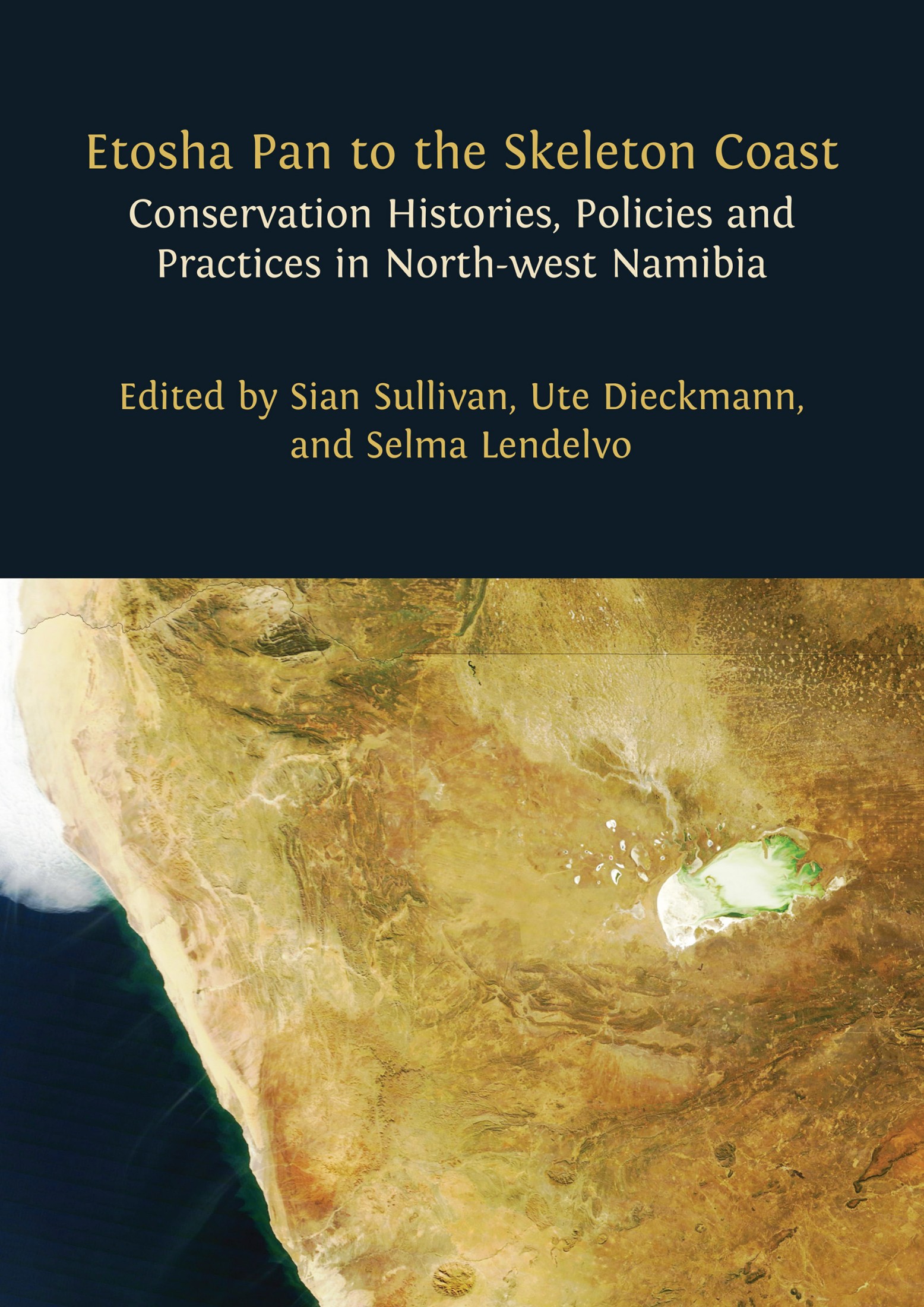11. Communities and elephants in the northern highlands, Kunene Region, Namibia
©2024 Michael J. Wenborn, et al., CC BY-NC 4.0 https://doi.org/10.11647/OBP.0402.11
Abstract
We consider a unique population of elephant (Loxodonta africana) dwelling in an area known as the northern highlands to the west of Etosha National Park. These highlands are a remote, arid, mountainous landscape where elephants co-exist with rural communities. There is minimal published research on this population of elephants. As part of our scoping for a research project on this population of elephants, we consulted with game guards from 10 conservancies in 2021 and 2022 on their knowledge of elephant populations. We also carried out analysis of Event Book data on human-elephant conflict incidents reported in Orupupa and Ehi-Rovipuka conservancies. The community conservancy model has had much success in shaping local attitudes in Kunene Region and increasing the perceived value of wildlife. These successes are being eroded, however, by competition between local people and wildlife over resources—particularly in the context of drought years in north-west Namibia from 2013. We conclude that there is a strong case for expanding the roles of community game guards to strengthen the protection of the elephants in the northern highlands. One suggestion is for community game guards to be offered additional training as “elephant rangers” who can guide tourists in the area, the assumption being that this would increase revenue to community conservancies and help to enhance local perceptions of the value of wildlife.
11.1 Introduction1
The status of the African savanna elephant (Loxodonta africana) was amended in 2021 from Vulnerable to Endangered in the Red List of Threatened Species compiled by the International Union for Conservation of Nature (IUCN).2 This change in classification was based on the estimated total population of 415,000 African savanna and African forest (Loxodonta cyclotis) elephants in 2016, indicating a 30% decline in total population since 2006. The reduction in total population has been widely reported to be mainly because of poaching and loss of habitat.3
The IUCN compiles the African Elephant Database from surveys of elephants and publishes reports on the status of the species, including disaggregation for different range countries. According to the database, Namibia has the 5th highest estimated national population of elephants in Africa.4 The IUCN African Elephant Status Report estimates that the elephant population in Namibia was around 22,700 in 2016.5 About 85% of the population is located in the north-east of the country in the Zambezi and Khaudom-Kavango Regions (Figure 11.1). The estimated total elephant population in Namibia is uncertain because large numbers of elephants in the north-east regularly move across borders into Botswana, Angola and Zambia, so the total population greatly varies over time. Other ranges in Namibia include a population in Etosha National Park (ENP) (estimated to be about 2,900 elephants6); and in the Kunene Region in north-west Namibia. The information in the database indicates that the elephants in Kunene Region are estimated to be about 1.5% of the Namibian elephant population, with approximately 300 elephants over a very large area of at least 41,000 km2.7
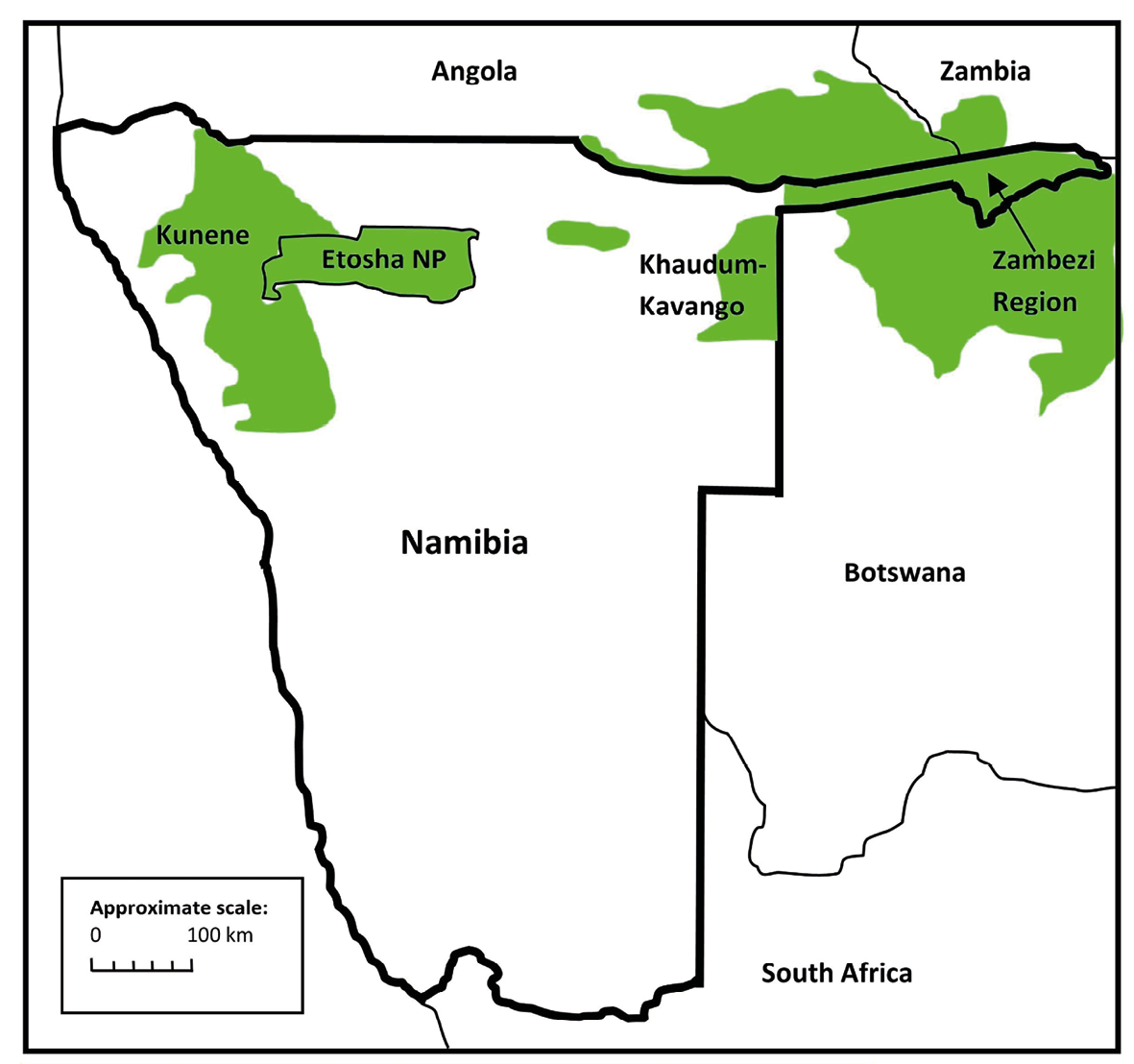
Fig. 11.1 Map showing the elephant population ranges in Namibia. Source: adapted from Thouless et al. (2016: 174), CC BY-NC-ND 4.0.
The elephant range in north-west Namibia includes a remote, mountainous landscape to the west of ENP and north of the Ombonde River, referred to locally as the northern highlands (Figure 11.2). The highlands cover a large area of approximately 12,000 km2 (more than half the size of ENP), with steep, rocky valley sides and peaks up to 1,800 m above sea level. There are many natural springs in the highlands, which support diverse wildlife. Elephants move in and out of the northern highlands and drink from these springs, as well as from community water points (Figure 11.3). Elephant numbers in north-west Namibia have widely fluctuated since records began. There was much elephant hunting for ivory in the area in the late 1800s and early 1900s (see Chapter 1),8
and the population again declined in the 1950s and 1960s because of droughts and the policy of the South African administration to encourage livestock farming and the elimination of game.9 The desert-adapted elephants to the west of the highlands below the escarpment towards the Skeleton Coast National Park (SCNP), have been extensively studied in the lower Hoanib and Hoarusib River catchments.10 The desert-adapted elephants have also had much media coverage.11 To the east of the highlands, the elephants in ENP have been well studied, particularly by research teams of the Ministry of Environment, Forestry and Tourism (MEFT),12 however, there is minimal published information on the elephants in the northern highlands specifically.
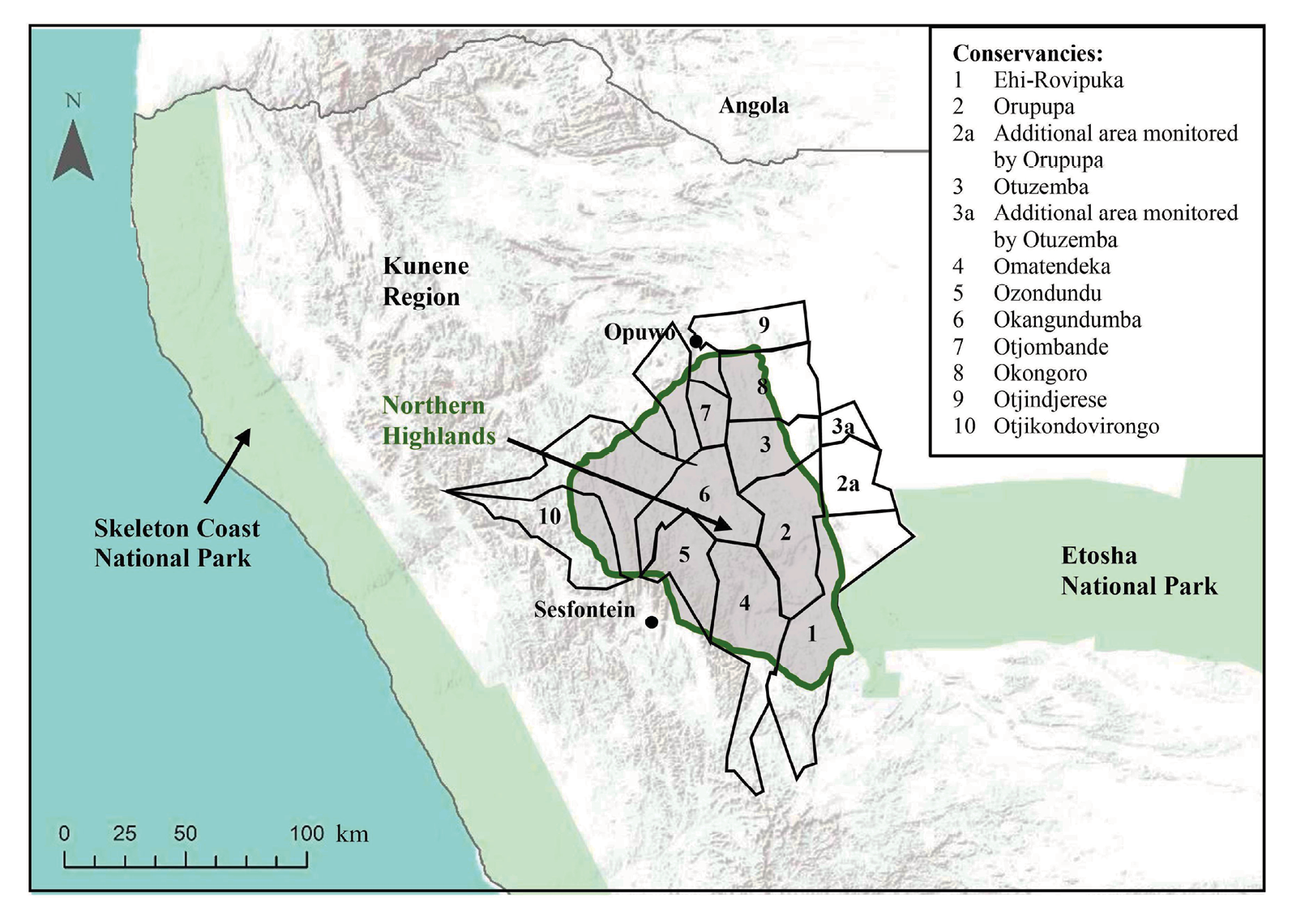
Fig. 11.2 The northern highlands, showing the conservancies consulted during the scoping study reported here,
CC BY-NC-ND 4.0.
The desert to semi-desert landscape of north-west Namibia has low rainfall (typically 50 to 250 mm per year),13 with the rainy season being unpredictable. There have been several drought years in north-west Namibia since 2013, with heavy rains breaking this dry period across the area in early 2022, but 2023 being once again very dry.14 When it occurs, rainfall tends to be localised and can be extremely heavy, causing soil erosion problems, a situation perceived to be made worse by cattle grazing in the area.15
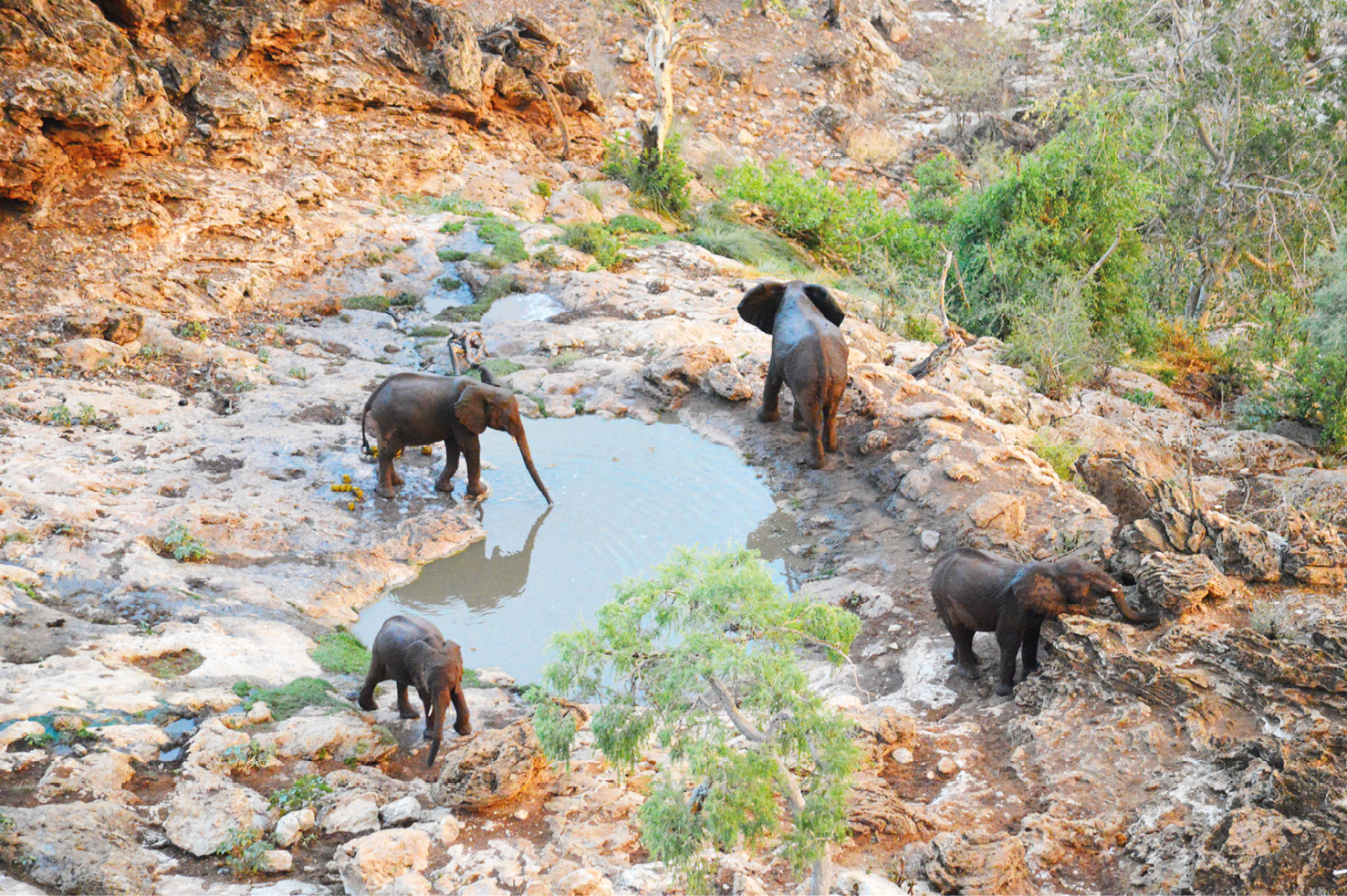
Fig. 11.3 Springs in the northern highlands are important for elephants and other wildlife.
Photo: © Michael Wenborn, 21.1.2018, CC BY-NC-ND 4.0.
There are many villages across the northern highlands, and local people carry out their day-to-day lives alongside the population of elephants. The estimated human population in the northern highlands is under 10,000, with a low human population density of around one person/km2.16 Local communities in the northern highlands are some of the poorest in Namibia, with 39% of the population in the Kunene Region classified as poor in 2011 (i.e. individuals living on less than US$1/day)17 (also see Chapter 3). Livestock farming (cows and goats) is the main livelihood for the communities in the north-west (see Figure 11.4).18 There was a high loss of livestock in 2018–2019 because of drought, which has added to problems of local poverty.19 There was also an added loss of employment and/or income for many households in Namibia during the COVID-19 pandemic.20
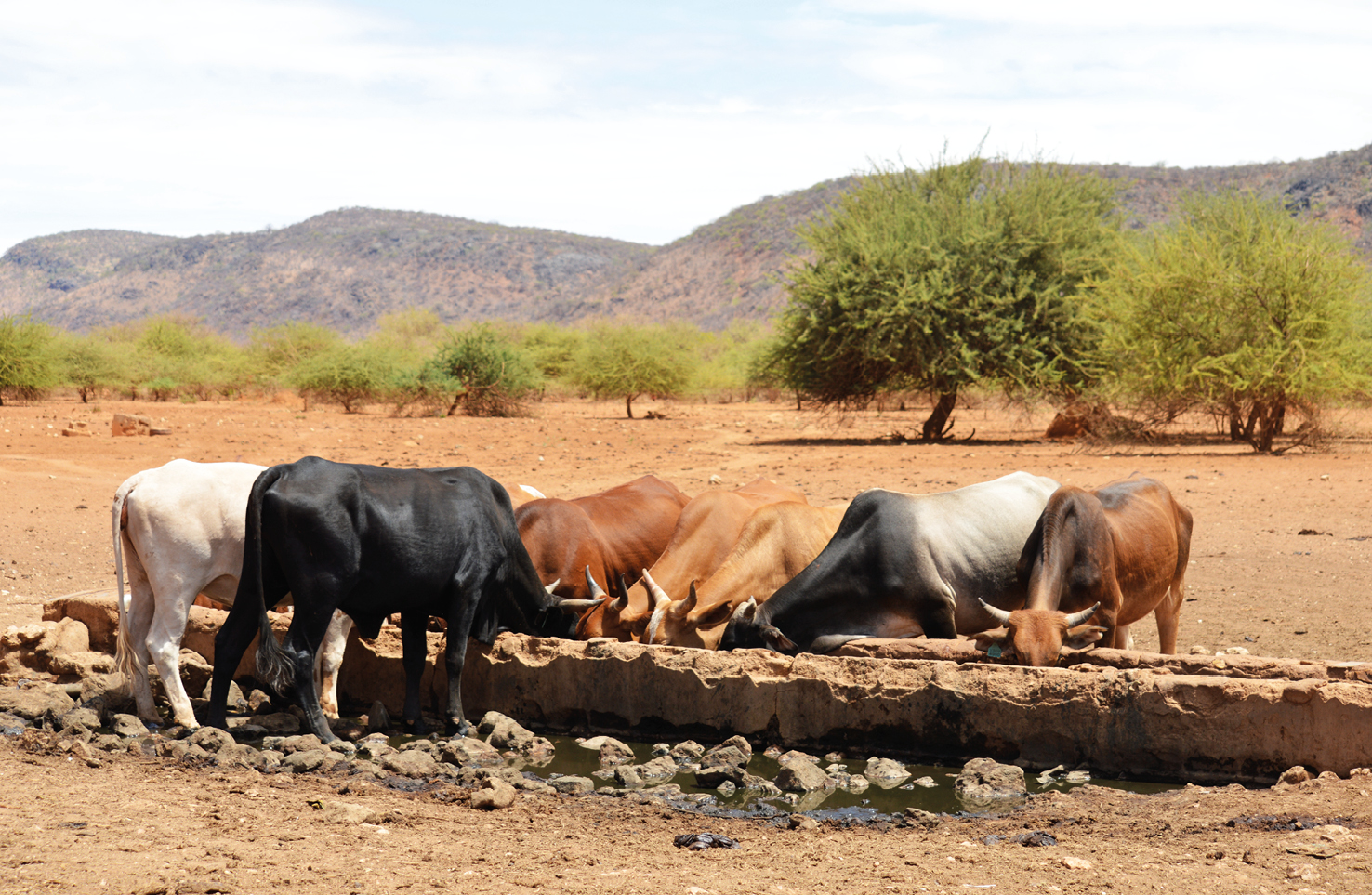
Fig. 11.4 Livestock forms the basis of livelihoods in the northern highlands. This photo provides an example of soil trampling and heavy grazing by cattle near water points, Omunuandjai in Okangundumba Conservancy.
Photo: © Michael Wenborn, 12.1.2021, CC BY-NC-ND 4.0.
Since 2001, most of the area of the northern highlands has been formally designated as community wildlife conservancies (Figure 11.2). The communal area conservancy model has successfully enhanced local commitment to wildlife conservation through its focus on helping local communities gain some revenue from wildlife: see Chapters 3 and 5.21 Community Game Guards (CGGs) are employed by the conservancies with roles to monitor wildlife, record incidents of “human-wildlife conflict” (HWC) (e.g. livestock kills by predators, elephant damage at water points and vegetable gardens), and raise awareness in communities on the benefits of wildlife protection. Increased local poverty, lack of investment in tourism for many conservancies, and human-wildlife conflict, however, have the potential to erode the commitment of local people to wildlife conservation.
The number of elephants and the movements of the elephant population in the northern highlands are uncertain. A detailed understanding of the population and migration routes of the elephants, including the factors affecting their movements, is needed for planning the protection of this population, as well as reducing human-elephant conflict (HEC). More information on the elephants will also provide benefits to community conservancies in terms of planning and promoting tourism opportunities.
11.2 Method
We carried out an extended scoping study on the situation in the highlands related to local ecological knowledge and problems with human-elephant conflict. This was part of the early planning of a self-funded research project to address a gap in research on the population and movements of elephants in the northern highlands in association with Oxford Brookes University, UK. This chapter summarises some of the main findings from our scoping study. After a detailed literature review, we consulted with 21 Community Game Guards (some individually and some in groups) and several chairpersons or committee members from 10 conservancies in the highlands, from January to March 2021 and February to March 2022. We discussed their knowledge of elephant populations and the trends in local challenges, including incidents of HEC. Part of the scoping study included field trips with game guards to water points visited by elephants, and walking up mountain pathways to identify evidence of elephant movements. The consultation and field observations particularly focused on Orupupa (10 consultation meetings), Otuzemba (three), Ehi-Rovipuka (three), Omatendeka (eight), Ozondundu (five) and Okangundumba (two) conservancies; we also had one consultation with each of the Okongoro, Otjombande, Otjindjerese and Otjikondovirongo conservancies (for locations see Figure 11.2).
The game guards have been collecting data for around 20 years in Event Books as part of their role within conservancies (Figure 11.5). The information recorded includes elephant sightings from foot patrols, and details and locations of reported incidents involving elephants, such as damage at water points. We also analysed Event Book data on HEC incidents reported in Ehi-Rovipuka and Orupupa conservancies.22 Our analysis had the support of the game guards and the agreement of the conservancy chairpersons.
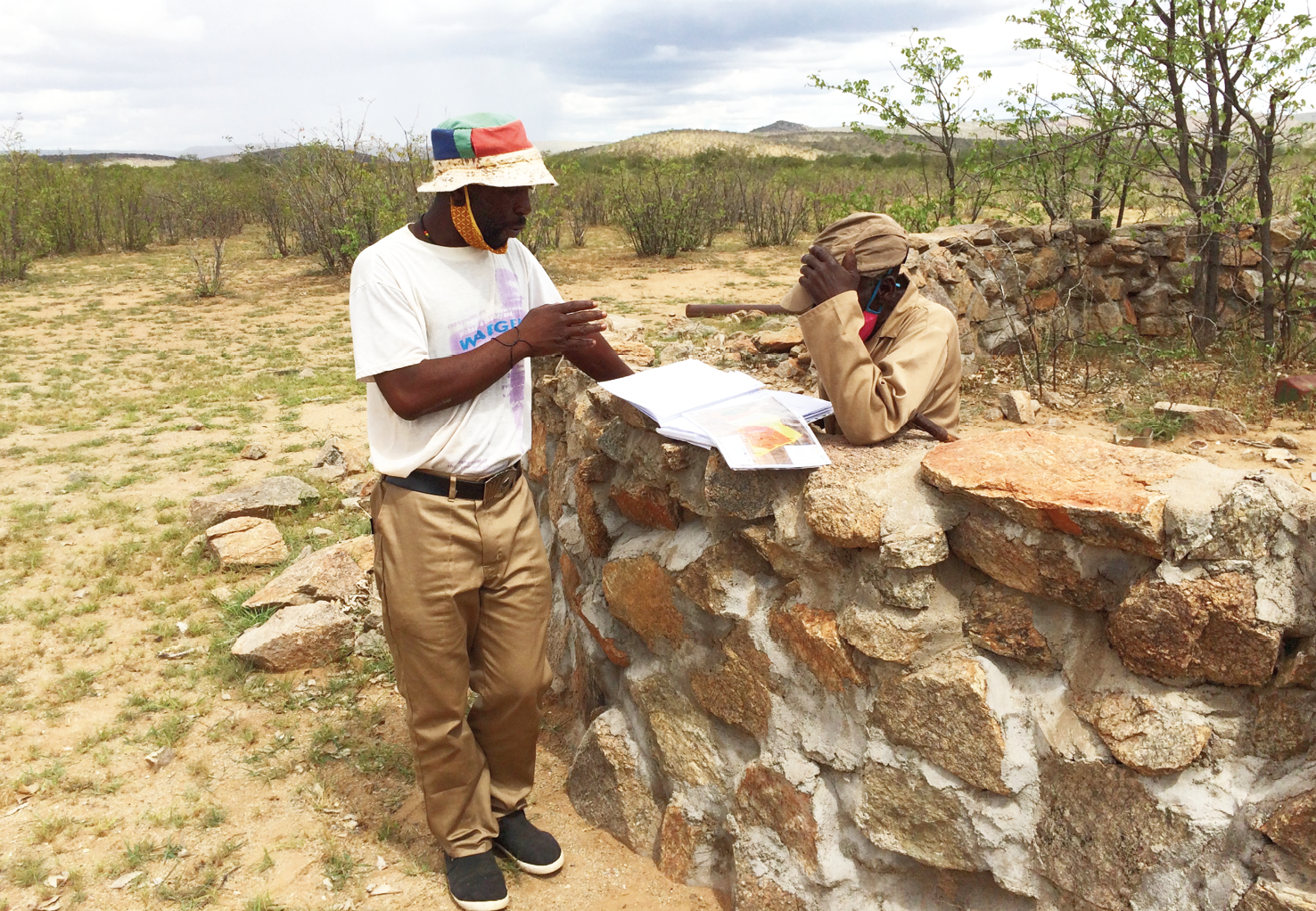
Fig. 11.5 A game guard and a community member in Orupupa Conservancy, discussing conservancy Event Book data and typical elephant movements. Photo: © Michael Wenborn, 25.3.2021, CC BY-NC-ND 4.0.
11.3 Results and discussion
This section includes discussions of local knowledge on the population and movements of elephants, trends in human-elephant conflict, and the importance of the local ecological knowledge of game guards.
11.3.1 Elephant and human populations in the northern highlands
Our literature review, as part of the scoping research, revealed that there is minimal published information on elephants in the northern highlands. The MEFT has carried out a few monitoring surveys of elephants and other wildlife in north-west Namibia, but the mountainous terrain and large area mean it is difficult and expensive to carry out comprehensive surveys. The estimation of the elephant population in the north-west from these surveys, on which the estimate in the IUCN African Elephant Status Report is based,23 has a high level of uncertainty.
Phillip Viljoen of the University of Pretoria carried out extensive ground surveys in the late 1970s and 1980s, which raised the profile of the elephants in remote north-west Namibia, particularly regarding the desert-adapted elephants.24 The late Garth Owen-Smith, one of the pioneers of the community wildlife conservancy model in Namibia, also kept extensive records on wildlife in north-west Namibia from the 1960s onwards.25 In the 2000s Keith Leggett of the University of New South Wales, published several papers on his research on the population dynamics of desert-adapted elephants.26 This research, however, tended to focus on the desert-adapted elephants in the lower Hoanib and Hoarusib river catchments, rather than the specific population of elephants inhabiting the northern highlands.
Given the scarcity of published research on elephants in the northern highlands, we relied to a large extent on information provided by the CGGs who work for communal area conservancies. They have extensive knowledge of elephant populations, elephant behaviour and movements. According to the game guards, the main conservancies in the northern highlands currently with elephant populations are in the south and eastern part of the highlands, namely Ehi-Rovipuka, Orupupa, Otuzemba, Omatendeka, Okangundumba and Ozondundu (Figure 11.2).
There was common feedback from the game guards we consulted that elephants easily and regularly move up and down slopes in the area. During our foot surveys in the northern highlands with game guards, we observed trees on steep slopes that had been partly eaten by elephants. Elephant dung was also observed on steep mountain paths and on mountain ridges (Figure 11.6). Observations of elephant movements on the mountain slopes in north-west Namibia have been recorded in the past.27 The 1934 book by Shortridge compiled records of mammals in the former South West Africa, including observations on elephants in the early 1920s, stating that ‘in mountainous districts, elephants show an astonishing aptitude for climbing’, and ‘the elephant is the best judge of gradient’.28
The elephant population in north-west Namibia might therefore be unique in terms of walking up mountains, which is unusual behaviour for most populations of the African savanna elephant,29 a species often associated with the flat plains of Africa. The game guards said that elephants tend to stay in the mountains and valleys away from villages during the day, but in the dry season visit some village water points at night. Common feedback from game guards was that the elephants ascend slopes to access some of their preferred tree species, particularly the African star-chestnut (Sterculia africana) and blue-leaved corkwood (Commiphora glaucescens), which tend to grow on rocky slopes.30
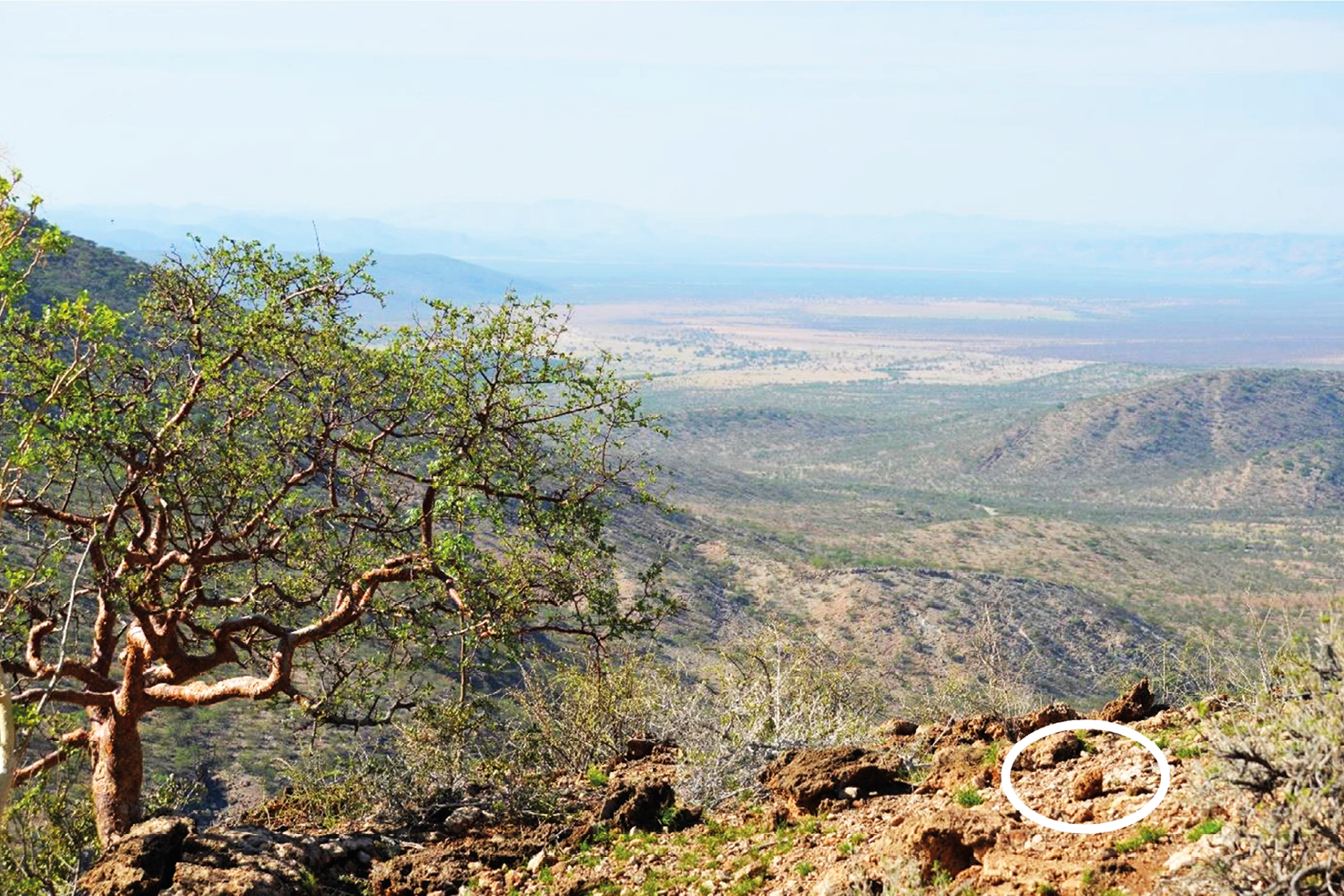
Fig. 11.6 Observation of elephant dung (circled in white) at the top of a mountain near Otjisakamuka in Omatendeka Conservancy. Photo: © Michael Wenborn, 2.4.2021, CC BY-NC-ND 4.0.
The feedback from game guards is that, over time, elephants create pathways by clearing bushes. We noted that the well-used elephant pathways tend to align with an easy gradient up the slopes, although we did observe evidence of elephants taking steeper ascents/descents on occasion. In one case we observed elephant dung on one of the 4x4 vehicle tracks in Orupupa Conservancy, which has a particularly steep slope (estimated at least one in three steepness—about a 20o gradient).
Several game guards have 10 to 20 years’ experience in their roles, and there has been a consistent method of monitoring and recording in Event Books for this period in most conservancies. The roles and experience of the game guards mean they also have interesting stories about trends in elephant behaviour. Although much of the information given by them is anecdotal, it does provide some useful indications of how the behaviour of elephants could be changing. For example, in the dry season (June to December) the herds tend to stay in the nearby hills during the day, where their preferred vegetation is growing, and visit community water points on some nights. During the rains (for the years when there are rains), the main herds tend to visit water points in villages much less frequently. There was some feedback that some herds at these times do not move long distances and tend to stay in areas with good vegetation and standing water. This anecdotal information also ties in with previous observations reported in publications,31 but needs verification through monitoring activities with GPS (Global Positioning System) collars.
Most game guards stated that elephants regularly visit the area of the conservancy under their responsibility. Several game guards can recognise a few of the herds that regularly visit, usually through herd size and identifying features on the ears, tusks and tails of the larger elephants. Other herds sometimes come into the conservancy for just two or three days but these visit much less frequently and are not yet recognised by the game guards.
The initial feedback from most game guards consulted was that there used to be more movement between ENP and the northern highlands, but their perception is that there have been fewer movements in recent years. An exception is Ehi-Rovipuka Conservancy, which is adjacent to ENP (see Chapter 14): its game guards observe frequent movement of one or two herds in and out of Etosha in the north of the Conservancy—the state-of-repair of the fence to the Park varies and in many places is not able to keep elephants inside the Park. The feedback during our consultation was that the number of elephants in the area has been increasing over the last 10 to 20 years. Several game guards had observed new herds entering their area in recent years.
The knowledge of the game guards mainly relates to their local area, and they tend to have less experience of wider strategic planning at regional level. We conclude, however, that there is potential for collating local ecological knowledge to provide sufficient information on the populations and movements of elephants for use as a basis for planning conservation management measures to reduce HEC and protect elephants in the northern highlands. Expanding the monitoring activities of game guards to include identification and recording of specific elephant herds would improve knowledge of the elephant population and movements. This information could be used at a regional and local level, and should also be integrated into an Early Warning System between villages about elephant movements. The game guards would need the necessary equipment for elephant identification, and some training. The Namibian NGO Elephant-Human Relations Aid (EHRA), has developed a method for elephant identification and is testing the method in elephant ranges to the south of the northern highlands. Lessons could also be learned from rhino monitoring activities to the south of the highlands by the Namibian NGO Save the Rhino Trust (SRT).
11.3.2 Human-elephant conflict
There is increasing competition in north-west Namibia between livestock and wildlife over water and vegetation, as indicated by records in Event Books by game guards32 and in published research.33 The situation on the ground is complicated, however, by a number of factors, including the importance to local communities of livestock farming and declines in prey populations, especially in the north-west.34 North-west Namibia has a fragile, but resilient, ecosystem. Future droughts and other events linked to climate change are likely to further increase the impacts on the ecosystem and local competition in rural areas for water resources and vegetation.35 Elephants in the north-west are vulnerable to changes in access to water and other factors that affect migration routes. For example, the drilling of artificial water points in some areas of the north-west has facilitated the expansion of livestock grazing and potentially affected the range areas of elephants36 (also see Chapter 7). Research on the number of elephants and factors affecting their movement is a priority so that management measures can be planned to protect this unique, but vulnerable, population of elephants and their habitats.
There have been challenges with HEC in the elephant range across the north-west, at water points and in vegetable gardens. Our analysis of Event Books over 10 years of records from 2012 to 2021 in Orupupa and Ehi-Rovipuka conservancies (Figure 11.2), indicates that the frequency of incidents involving elephants is low, with typically about two to three incidents reported per month on average across each conservancy (Figure 11.7). Even though the frequency of reported incidents is low, however, the damage by elephants at a water point in a village can have a substantial impact on the community. When water infrastructure is damaged, in practice it often takes much time to repair, partly because of the large distances to travel to suppliers to buy parts and equipment. In these cases, people then have to visit other villages or cattle posts to obtain drinking water for themselves and their livestock. One of the main actions villagers can take to reduce damage at water points is to ensure that the holding dams, which have been installed at most water points, are full of water for elephants to drink, because damage often occurs when elephants find no water in the dams but they smell water in the pipes.
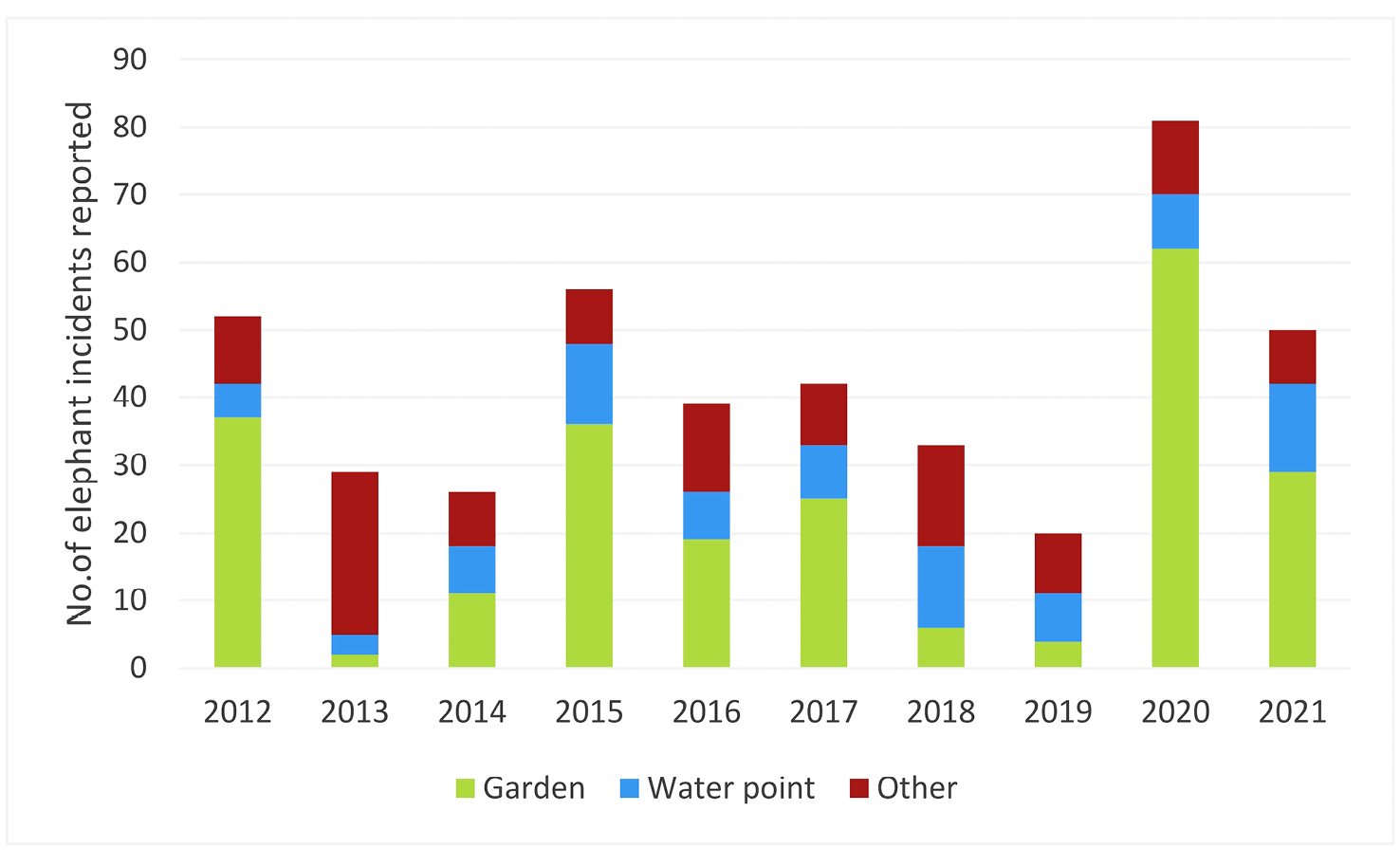
Fig. 11.7 Graph showing trends in total human-elephant incidents recorded by game guards in Ehi-Rovipuka and Orupupa conservancies (the “other” category includes damage to property, kraals, etc). Source: surveyed conservancy Event Books, 2012–2021, CC BY-NC-ND 4.0.
At the same time, however, when elephants drink the water that has been pumped into a holding dam for livestock, this often results in a substantial financial cost for the village in terms of the diesel needed to pump the extra groundwater (see also Chapter 7).
Although such cases are not recorded in Event Books, they do affect community attitudes towards elephant conservation. Several water points have been upgraded to include protection from elephants at holding tanks and troughs (Figure 11.8), and to install solar pumps, which reduces operational costs. Such upgrades tend to be funded by the national government or donor organisations, sometimes via NGOs. The upgrades are a priority for many villages and cattle posts in the conservancies and are included as an important action for the north-west in the National Elephant Conservation and Management Plan of 2021.37
Discussions with game guards and the local community have confirmed that the widespread loss of livestock in the north-west during the droughts of 2018 and 2019 in particular, led to many people starting community vegetable gardens near their water points (Figure 11.9). This new wave of gardening provides sources of food for households, and is much needed because of the loss of livelihoods and income due to drought-related reductions in livestock. Although vegetable growing has been practised in the area for many years, this is an example of the changing situation related to HEC in north-west Namibia. The game guards stated that although typically elephants tend to stay away from villages during the rainy season because they have access to water elsewhere, the recent set up of vegetable gardens has resulted in some visits of elephants to villages during the rainy season. Figure 11.7 demonstrates an increase in incidents at vegetable gardens in 2020 in particular, and 2021. There have also been other years (e.g. 2015) with higher incidents at vegetable gardens.

Fig. 11.8 Pipework damage by elephants at the water point in Okazorongua village, Orupupa Conservancy. Photo: © Michael Wenborn, 1.4.2021, CC BY-NC-ND 4.0.
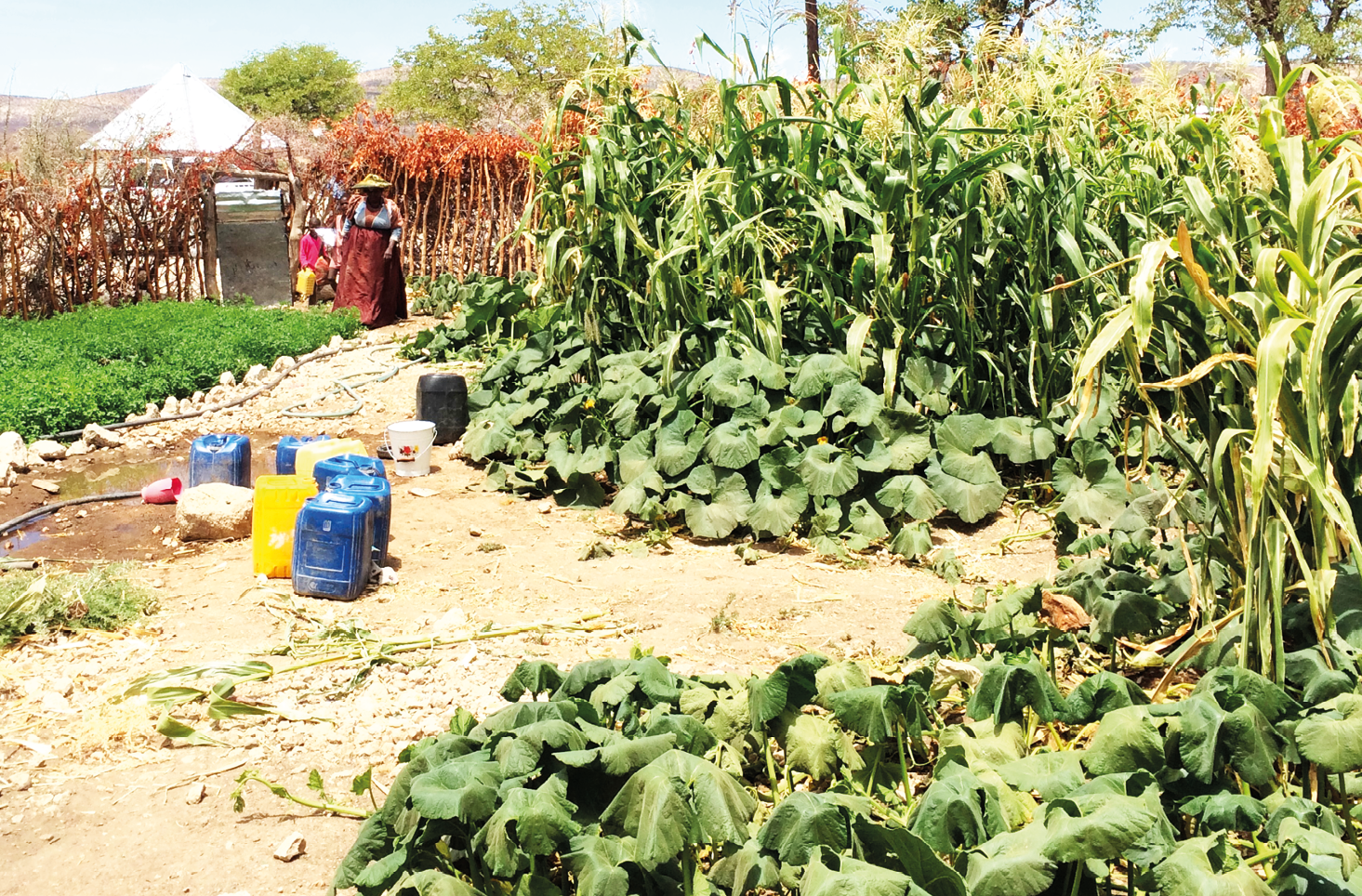
Fig. 11.9 Vegetable garden, Ombombo village, Okangundumba Conservancy. Photo: © Michael Wenborn, 12.1.2021, CC BY-NC-ND 4.0.
Our consultation found that the common perception of game guards in Ehi-Rovipuka and Orupupa conservancies is that there has been an increase in total incidents of HEC over the last 10 years.38 Figure 11.7 implies the increase has only been in 2020 and 2021. Overall, the Event Book recordings depend on the mobility and motivation of game guards. Although there is some uncertainty in the data, the Event Book results do provide an overall indication of the challenges with human-wildlife conflict (HWC), including the locations of incidents.
Further work is needed to compare community concerns on incidents of HEC to incidents of predator attacks on livestock (see Chapters 17, 18 and 19). This is important in the context of the strong traditional culture related to livestock farming.39 Predator attacks made up about 80% of the human-wildlife incidents reported in the Event Books for Orupupa from 2012 to 2020.40 The recorded predator incidents mainly involved spotted hyena (Crocuta crocuta), cheetah (Acinonyx jubatus) or leopard (Panthera pardus). The MEFT in some cases provides payments to farmers to offset some of the costs of loss of livestock from predator attacks,41 as it does for some incidents of damage caused by elephants.
11.3.3 Importance of game guard knowledge
Game guards play an important role in the conservancies to collect and record data from their sightings of elephants, which provides information on elephant populations and movements. As mentioned, they also record incidents of HEC in Event Books, the use of which has become established in community conservancies in Namibia. All these monitoring activities support the implementation of actions in the National Elephant Conservation and Management Plan.42
The problems with damage by elephants at water points and vegetable gardens, as well as concerns over predators taking any remaining livestock and the lack of investment in wildlife tourism (partly because of the COVID-19 pandemic), all contribute to the risk of local reduction in support for wildlife conservation. We suggest, however, that the scenic and remote landscape of the northern highlands, with a diversity of wildlife and cultural heritage, has a high potential for tourism. Diversifying livelihoods away from livestock farming has for some time been a development objective of the Government of Namibia43 (see Chapter 3). Wildlife tourism, planned in a controlled manner to protect habitats and wildlife, has been identified by the government as an opportunity to benefit some of the communities in Kunene Region, to contribute towards diversifying livelihoods and to rebuild local commitment to wildlife conservation.44 The elephants in the northern highlands could be a core driver of tourism in the area. The elephants provide the opportunity to generate revenue as game guards could be trained and developed into local guides for wildlife tourism. Expanding their role into elephant rangers could build on their considerable knowledge of elephant movements and behaviour, and their stories on elephants: these are not only useful as anecdotal information for research but would be of interest to tourists. The potential new revenue would enhance the income of game guards, many of whom are currently paid very low salaries, and could also be used to buy equipment for game guards, most of whom do not even have binoculars. Additional revenue could be used by the conservancies to provide benefits and/or damage repair and compensation to communities, thereby encouraging commitment to wildlife conservation (although see Chapter 5 for a discussion of complexities around income- and benefit-sharing in conservancies).
There are frameworks already in place to facilitate a system of elephant rangers. The community conservancies already have systems for revenue collection and financial management and reporting. There are several Namibian NGOs with a remit to promote wildlife tourism and/or wildlife conservation, including TOSCO (Tourism Supporting Conservation Trust), IRDNC (Integrated Rural Development and Nature Conservation), WWF (World Wide Fund for Nature)-Namibia, SRT, EHRA and NACSO (Namibian Association of CBNRM Support Organisations), who work together and with the MEFT to support communities in the north-west. More recently, UK-based environmental organisation Conserve Global45 has shown an interest in this area of the “Kunene Highlands”. There are commercial travel agents at a central level that organise the bookings of accommodation and guides, and their roles could be expanded to book elephant rangers through the conservancies, in particular for self-drive tourists but also guided groups. At a practical level, the mobile phone network has been expanding in recent years in the north-west which would enable efficient booking of elephant rangers. In addition, most current game guards speak English to an adequate level for such tourism guiding. Our thinking is that tourists could make a booking and meet the elephant ranger at a specified time and place. In practice, the drive could cross conservancy boundaries, as there are several examples of conservancies already cooperating to share responsibilities on wildlife tourism and to share revenues. IRDNC in particular has a strong track record in fostering and co-ordinating such cooperation.
11.4. Conclusion
We conclude that most game guards in the northern highlands have good levels of local ecological knowledge that could provide sufficient information on the populations and movements of elephants as a basis for planning conservation management measures. Such measures can help reduce human-elephant conflict and to protect elephants in the northern highlands. The knowledge of elephant populations and movements would be improved by expanding the monitoring activities of game guards to include identification and recording of specific elephant herds.
Expanding the roles of game guards and their integration into tourism as elephant rangers may also contribute benefits that conservancies gain from wildlife, thereby strengthening the acceptance of communities to share the same area. The initial investment needed is relatively small: binoculars, uniforms, walking shoes, mobile phones, wildlife identification books, cameras and spotlights; and training in tourism guiding (including safety). Community game guards, through their local ecological knowledge, can therefore increase their important role in the future success of the conservancy model. Elephant-based tourism would be a relatively small contribution in terms of revenues and employment to shifting livelihoods in the region, but also a potentially quick intervention. It would build on the existing knowledge of many of the game guards, with existing community-based structures the basis for implementation of an “elephant ranger-led” tourism experience.
Bibliography
BBC 2008. Elephant Nomads of the Namib Desert, https://www.bbc.co.uk/programmes/b009p9mk
BBC 2019. Seven Worlds, One Planet—Africa (Episode 7), https://www.bbc.co.uk/iplayer/episode/m000c6pn/seven-worlds-one-planet-series-1-7-africa
Berry, H.H. 1997. Historical review of the Etosha region and its subsequent administration as a National Park. Madoqua 20(1): 3–10, https://hdl.handle.net/10520/AJA10115498_453
Blanc, J. 2008. Loxodonta africana. The IUCN Red List of Threatened Species 2008, https://www.iucnredlist.org/species/12392/3339343
Bollig, M. 2020. Shaping the African Savannah: From Capitalist Frontier to Arid Eden in Namibia. Cambridge: Cambridge University Press, https://doi.org/10.1017/9781108764025
Bollig, M. and Olwage, E. 2016. The political ecology of hunting in Namibia’s Kaokoveld: From Dorsland Trekkers’ elephant hunts to trophy-hunting in contemporary conservancies. Journal of Contemporary African Studies 34(1): 61–79, https://doi.org/10.1080/02589001.2016.1182745
Chase, M. and Landen, K. 2019. Counting elephants. In D. Pinnock and C. Bell (eds.) The Last Elephants. Cape Town: Penguin Random House, 18–25.
Chase, M.J., Schlossberg, S., Griffin, C.R., et al. 2016. Continent-wide survey reveals massive decline in African savannah elephants. PeerJ, 4: e2354, https://doi.org/10.7717/peerj.2354
CITES 2016. Report on Monitoring the Illegal Killing of Elephants (MIKE), CITES Seventeenth Meeting of the Conference of the Parties, Johannesburg (South Africa), 24 September to 5 October 2016. CITES, CoP17 Doc. 57.5, pp. 1-18, https://cites.org/sites/default/files/eng/cop/17/WorkingDocs/E-CoP17-57-05.pdf
CNN 2022. Desert Elephants are Finding Friends in the Drylands of Namibia, https://edition.cnn.com/2022/10/17/africa/namibia-desert-elephants-scn-c2e-spc-intl/index.html
Gobush, K.S., Edwards, C.T.T, Balfour, D., Wittemyer, G., Maisels, F. and Taylor, R.D. 2021. Loxodonta africana. The IUCN Red List of Threatened Species 2021, https://dx.doi.org/10.2305/IUCN.UK.2021-1.RLTS.T181008073A181022663.en
GRN 2015. Namibia Poverty Mapping Report. Windhoek: National Planning Commission, Government of the Republic of Namibia.
GRN 2017. Namibia’s 5th National Development Plan (NDP5): Working Together Towards Prosperity 2017/18-2021/22. Windhoek: National Planning Commission, https://www.npc.gov.na/wp-content/uploads/2021/11/NDP5.pdf
Hewitson, L. and Sullivan, S. 2021. Producing elephant commodities for ‘conservation hunting’ in Namibian communal-area conservancies. Journal of Political Ecology 28: 1–24, https://doi.org/10.2458/jpe.2279
Heydinger J. 2021. A more-than-human history of Apartheid technocratic planning in Etosha-Kaokoveld, Namibia, c.1960-1970s. South African Historical Journal 73: 64–94, https://doi.org/10.1080/02582473.2021.1909120
Heydinger, J. 2023. Eserewondo Rozongombe: Livestock as sites of power and resistance in Kaokoveld, Namibia. Environment and History 29(1): 79–107, https://doi.org/10.3197/096734020X15900760737293
Heydinger, J.M., Packer, C. and Tsaneb, J. 2019. Desert-adapted lions on communal land: Surveying the costs incurred by, and perspectives of, communal-area livestock owners in northwest Namibia. Biological Conservation 236: 496–504, https://doi.org/10.1016/j.biocon.2019.06.003
Hunninck, L., Ringstad, I.H., Jackson, C.R., May, R., Fossey, F., Uiseb, K., Killian, W., Palme, R. and Roskaft, E. 2017. Being stressed outside the park—conservation of African elephants (Loxodonta africana) in Namibia. Conservation Physiology 5(1): cox067, https://www.ncbi.nlm.nih.gov/pmc/articles/PMC5734242/
Inman, E.N., Hobbs, R.J., Tsvuura, Z. and Valentine, L. 2020. Current vegetation structure and composition of woody species in community-derived categories of land degradation in a semiarid rangeland in Kunene region, Namibia. Land Degradation and Development 31(18): 2996–3013, https://doi.org/10.1002/ldr.3688
IUCN 2020. IUCN SSC Position Statement on the Management of Human-Wildlife Conflict. IUCN Species Survival Commission (SSC) Human-Wildlife Conflict Task Force, https://www.iucn.org/sites/dev/files/ssc_human_wildlife_conflict_position_statement.pdf
IUCN 2021. Shrinking Spaces for the World’s Largest Land Animal, https://www.iucn.org/news/species-survival-commission/202108/shrinking-spaces-worlds-largest-land-animal
IUCN 2022. African Elephant Database, http://africanelephantdatabase.org/about
Jacobsohn, M. 2019. Life is Like a Kudu Horn: A Conservation Memoir. Cape Town: Jacana.
Korukuve, G.K. 2023. How climate change threatens the coexistence between communities and the Kunene highland elephants. Conservation Namibia 21.9.2023, https://conservationnamibia.com/blog/climate-change-and-elephant-coexistence.php
Leggett, K. 2006a. Home range and seasonal movement of elephants in the Kunene Region, northwestern Namibia. African Zoology 41: 17–36, https://doi.org/10.1080/15627020.2006.11407332
Leggett, K. 2006b. Effect of artificial water points on the movement and behaviour of desert-dwelling elephants of north-western Namibia. Pachyderm 40: 24–34, https://pachydermjournal.org/index.php/pachyderm/article/view/1259
Leggett, K., Brown, L. and Ramey, R. 2011. Matriarchal associations and reproduction in a remnant subpopulation of desert-dwelling elephants in Namibia. Pachyderm 49: 20–32, https://pachydermjournal.org/index.php/pachyderm/article/view/247
Leggett, K., Fennessy, J. and Schneider, S. 2003a. Seasonal distributions and social dynamics of elephants in the Hoanib River catchment, northwestern Namibia. African Zoology, 38: 305–16, https://hdl.handle.net/10520/EJC17882
Leggett, K., Fennessy, J. and Schneider, S. 2003b. Does land use matter in an arid Environment? A case study from the Hoanib River catchment, north-western Namibia. Journal of Arid Environments 53: 529–43, https://doi.org/10.1006/jare.2002.1066
Leggett, K., Fennessy, J. and Schneider, S. 2004. A study of animal movement in the Hoanib River catchment, northwestern Namibia. African Zoology 39: 1–11, https://hdl.handle.net/10520/EJC17916
Lendelvo, S., Mechtilde, P. and Sullivan, S. 2020. A perfect storm? COVID-19 and community-based conservation in Namibia. Namibian Journal of Environment 4(B): 1–15, https://nje.org.na/index.php/nje/article/view/volume4-lendelvo/43
le Roux, P, Müller, M., Mannheimer, C. and Curtis, B. 2018. Trees and Shrubs of Namibia. 2nd ed. Windhoek: Namibia Publishing House (Pty) Ltd.
MET 2013. National Policy on Community Based Natural Resource Management. Windhoek: Ministry of Environment and Tourism.
MET 2018. Revised National Policy on Human Wildlife Conflict Management 2018–2027. Windhoek: Ministry of Environment and Tourism, https://www.meft.gov.na/files/files/HWC%20revise%20Policy.pdf
MEFT 2021. National Elephant Conservation and Management Plan 2021/2022–2030/2031. Ministry of Environment, Forestry and Tourism, Namibia.
Mfune, J., Angula, M., Lendelvo, S. and Mosimane, A. 2013. Human-Wildlife Conflict Along the Borders of Etosha National Park. MRC/UNAM Technical Report.
NACSO 2017. Conservation Lands Under Threat, https://www.nacso.org.na/news/2017/07/conservation-lands-under-threat
NACSO 2019. The State of Community Conservation in Namibia: A Review of Communal Conservancies, Community Forests and other CBNRM Initiatives 2019. Windhoek: Namibian Association of CBNRM Support Organisations.
NACSO 2021a. The State of Community Conservation in Namibia: A Review of Communal Conservancies, Community Forests and other CBNRM Initiatives 2020. Windhoek: Namibian Association of CBNRM Support Organisations.
NACSO 2021b. Orupupa Natural Resource Report for 2020, https://www.nacso.org.na/sites/default/files/Orupupa%20Audit%20Report%202020.pdf
NACSO 2022. Registered Communal Conservancies, http://www.nacso.org.na/conservancies
Nattrass, N. 2021. Differentiation in economic costs and returns from living with wildlife in Namibian community conservancies. South African Journal of Economics 89(2): 282–300, https://doi.org/10.1111/saje.12265
NSA 2013 Profile of Namibia: Facts, Figures and other Fundamental Information. Windhoek: Namibia Statistics Agency.
Owen-Smith, G.L. 1972. Proposals for a game reserve in the western Kaokoveld. South African Journal of Science 68: 29–37, https://journals.co.za/doi/pdf/10.10520/AJA00382353_9803
Owen-Smith, G. 2010. An Arid Eden: One Man’s Mission in the Kaokoveld. Johannesburg: Jonathan Ball Publishers.
Ramey, R. and Brown, L. 2019. About Desert-Dwelling Elephants, https://desertelephantconservation.org/about-desert-elephants
Sasscal. 2023. Sasscal Weathernet. Available at: https://sasscalweathernet.org/
Schnegg, M. and Kiaka, R.D. 2018. Subsidized elephants: Community-based resource governance and environmental (in)justice in Namibia. Geoforum 93: 105–15, https://doi.org/10.1016/j.geoforum.2018.05.010
Shortridge, G.C. 1934. The Mammals of South West Africa, Vol. 1&2. London: Heinemann.
Sky Nature 2020. Wild Kingdoms: Desert Survivors, https://www.sky.com/watch/channel/sky-nature/wild-kingdoms/episodes/season-1/episode-1
Störmer, N., Weaver, L., Stuart-Hill, G., Diggle, R. and Naidoo, R. 2019. Investigating the effects of community-based conservation on attitudes towards wildlife in Namibia. Biological Conservation 233: 193–200, https://doi.org/10.1016/j.biocon.2019.02.033
Thouless, C.R., Dublin, H.T., Blanc, J.J., Skinner, D.P., Daniel. T.E., Taylor, R.D., Maisels, F., Frederick, H.L. and Bouché, P. 2016. African Elephant Status Report 2016: An update from the African Elephant Database. Occasional Paper Series of the IUCN Species Survival Commission, No. 60 (IUCN African Elephant Specialist Group).
Turpie, J., Midgley, G., Brown, C., Barnes, J, I., Pallett, J., Desmet, P., Tarr, J. and Tarr, P. 2010. Climate Change Vulnerability and Adaptation Assessment for Namibia’s Biodiversity and Protected Area System. Windhoek: Ministry of Environment and Tourism, Directorate of Parks & Wildlife Management.
Viljoen, P.J. 1987. Status and past and present distribution of elephants in the Kaokoveld, South West Africa/Namibia. South African Journal of Zoology 22(4): 247–57, https://doi.org/10.1080/02541858.1987.11448054
Viljoen, P.J. 1989a. Spatial distribution and movements of elephants (Loxodonta africana) in the northern Namib Desert region of the Kaokoveld, South West Africa/Namibia. Journal of Zoology 219(1): 1–19, https://doi.org/10.1111/j.1469-7998.1989.tb02561.x
Viljoen, P.J. 1989b. Habitat selection and preferred food plants of a desert-dwelling elephant population in the northern Namib Desert, South West Africa/Namibia. African Journal of Ecology 27: 227–40, https://doi.org/10.1111/j.1365-2028.1989.tb01016.x
Viljoen, P.J. and Bothma, J.P. 1990. The influence of desert-dwelling elephants on vegetation in the northern Namib Desert, South West Africa/Namibia. Journal of Arid Environments 18: 85–96, https://doi.org/10.1016/S0140-1963(18)30874-7
Wall, J., Douglas-Hamilton, I. and Vollrath, F. 2006. Elephants avoid costly mountaineering. Current Biology 16(14): 527–29, https://pubmed.ncbi.nlm.nih.gov/16860724/
Wenborn, M., Svensson, M.S., Katupa, S., Collinson, R. and Nijman, V. 2022a. Lessons on the community conservancy model for wildlife protection in Namibia. The Journal of Environment & Development 31(4): 375–94, https://doi.org/10.1177/10704965221121026
Wenborn, M., Nijman, V., Kangombe, D., Zaako, R.K., Tjimuine, U., Kavita, A., Hinu, J., Huwe, R., Ngarukue, V.J., Kapringi, K.J. and Svensson, M.S. 2022b. Analysis of records from community game guards of human-elephant conflict in Orupupa Conservancy, northwest Namibia. Namibian Journal of Environment 6(A): 92–100, https://nje.org.na/index.php/nje/article/view/volume6-wenborn
Wildblood, C. 2012. The Realm of the Desert Elephant. Leicester: Troubador Publishing.
1 Acknowledgements: We would like to acknowledge the support of Mr Kenneth |Uiseb (Ministry of Environment, Forestry and Tourism, MEFT) and the game guards of Ehi-Rovipuka and Orupupa conservancies. Our research was carried out in line with NCRST research permit RPIV01042025.
2 Blanc (2008), Gobush et al. (2021), https://www.iucnredlist.org/species/181008073/223031019
3 Chase et al. (2016), CITES (2016), Thouless et al. (2016), IUCN (2021)
4 IUCN (2022)
5 Thouless et al. (2016)
6 IUCN (2022)
7 Thouless et al. (2016)
8 Bollig & Olwage (2016)
9 Berry (1997)
10 Viljoen (1987), Viljoen & Bothma (1990), Leggett et al. (2003a, 2011), Ramey & Brown (2019)
11 BBC (2008), Wildblood (2012), BBC (2019), Sky Nature (2020), CNN (2022)
12 MEFT (2021)
13 NSA (2013)
14 Sasscal (2023)
15 Leggett et al. (2003b), NACSO (2017), Heydinger (2023)
16 NACSO (2022)
17 GRN (2015), Heydinger et al. (2019)
18 Bollig (2020), Heydinger (2021)
19 Inman et al. (2020)
20 Lendelvo et al. (2020)
21 Jacobsohn (2019), Störmer et al. (2019), NACSO (2021a), Wenborn et al. (2022a)
22 Conservancy Event Book data are increasingly being used by researchers as a source of information about wildlife sightings, incidents and the identification of “problem animals”, see for example, Hewitson & Sullivan (2021) and Nattrass (2021).
23 Thouless et al. (2016)
24 Viljoen (1987, 1989a, b), Viljoen & Bothma (1990)
25 Owen-Smith (1972)
26 Leggett (2006a)
27 Viljoen (1989b)
28 Shortridge (1934: 369)
29 Wall et al. (2006)
30 le Roux et al. (2018)
31 Viljoen (1989a), Leggett et al. (2004), Owen-Smith (2010)
32 NACSO (2021a)
33 Mfune et al. (2013), Hunninck et al. (2017), Schnegg & Kiaka (2018), MEFT (2021)
34 See data at https://www.nacso.org.na/sites/default/files/North%20West%20Game%20Count-Regional%202022%20final.pdf, also Chapter 3.
35 Turpie et al. (2010), Hunninck et al. (2017), Chase & Landen (2019), IUCN (2020)
36 Leggett (2006b)
37 MEFT (2021)
38 Wenborn et al. (2022b)
39 Heydinger (2023)
40 NACSO (2021b)
41 NACSO (2019)
42 MEFT (2021)
43 MET (2013), GRN (2017)
44 MET (2018)
45 Korukuve (2023), also https://conserveglobal.earth/kunene-highlands-namibia/
